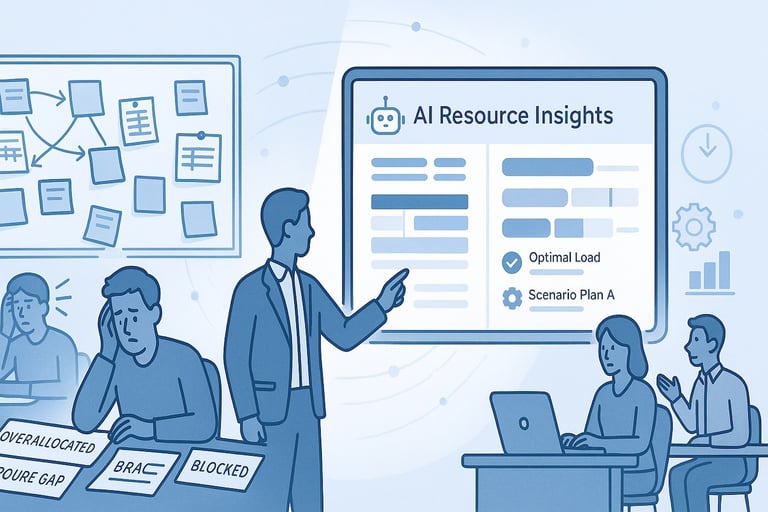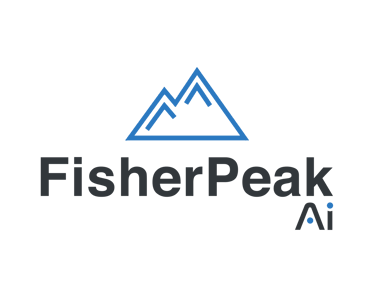Resource Chaos to Clarity: AI-Optimized Team Allocation
Struggling to balance project and operational workloads? Learn how AI can give your PMO real-time clarity and smarter resource decisions—no guesswork required.
AI IN PROJECT MANAGEMENT
Grant DeCecco
6/3/20253 min read


Resource Chaos to Clarity: AI-Optimized Team Allocation
How AI is helping PMOs assign the right people to the right work—at the right time
My name is Grant DeCecco, and I’ve spent the last 20 years helping organizations evolve through digital transformation. Today, I’m focused on the most significant shift of our time: how artificial intelligence is fundamentally reshaping the way we work, think, and solve problems.
If you've ever led a project where half your team was overbooked and the other half underutilized, you know how chaotic resource planning can be. I’ve seen it firsthand across every sector I’ve worked with—finance, tech, government, and healthcare. Even the most mature PMOs struggle to answer a basic question: Do we have the right people working on the right things?
AI is finally giving us the clarity we've needed.
The Reality: Resource Allocation Is Broken
Let’s call it what it is. Most project teams rely on:
Outdated spreadsheets
Gut feel
Annual capacity plans that are irrelevant by Q2
Project managers negotiating for headcount in weekly stand-ups
This leads to a painful cycle of:
Overworked teams
Idle specialists
Delays caused by resource bottlenecks
High attrition from burnout
The bigger the portfolio, the harder it is to manage. By the time issues surface in a status report, it’s usually too late.
AI Turns Resource Guesswork Into Strategy
AI-powered resource management changes everything. It analyzes real-time data, models future scenarios, and offers optimized allocation suggestions. And it does it continuously.
Here’s how organizations are using AI right now:
Dynamic Capacity Forecasting
Tools like Wrike Work Intelligence and Asana Intelligence monitor team utilization and forecast when skills will be under or over capacity—before the crunch hits (Source).Skill-Based Assignment
AI matches people to work based on past performance, availability, and role-specific context. ClickUp’s AI features surface the best-fit team members automatically for new tasks (Source).What-If Scenario Planning
AI can simulate changes to resourcing plans. What happens if your lead dev goes on leave? If a project shifts to Q4? You get options—not just issues.Workload Balancing
Jira’s Atlassian Intelligence adjusts allocations automatically when tasks run long or blockers pop up, helping avoid fire drills and panic reassignments (Source).Outcome Impact Tracking
AI doesn’t stop at allocation. It connects resource changes to delivery impact, helping teams justify headcount adjustments with data.
Real-World Example: From Resource Chaos to Enterprise Clarity
A client I worked with struggled to get a true enterprise view of resource allocation. Teams used a mix of project trackers and operations logs, but there was no unified model to plan around. The biggest challenge? Supporting unpredictable operational work alongside project delivery—and getting operations teams on board with change.
We addressed this by designing an enterprise resource tracking framework that served both project and operational needs. It was implemented using OnePlan to provide a single, integrated view of all resource commitments.
The outcome:
Leadership gained visibility into total capacity across the enterprise
Scenario planning tools allowed simulation of project delivery at different times
AI-powered forecasting helped model resource demand based on annual work plans
PMO and ops teams were able to co-manage priorities and adjust plans as business needs evolved
This didn’t just improve planning—it created a more realistic enterprise delivery model that stayed flexible throughout the year.
Try It Yourself: AI-Powered Resource Insights (Custom GPT)
To help you explore this for yourself, I built a sandbox-ready Custom GPT preloaded with realistic project data:
👉 Project Management Assistant (Custom GPT)
This assistant uses the kind of Word and Excel files most PMOs already manage—project charters, resource lists, task breakdowns. No specialized tools required.
It’s designed to show you what’s possible, even before integrating AI into enterprise platforms.
Sample Prompts You Can Use
Copy and paste these into the GPT to get started:
“Identify overallocated roles across all current projects.”
“Provide an assessment of potential blind spots in management of projects.”
“What trends are there in current risk management across projects?”
“Suggest options for delivering Project Orion sooner without adding significant risk.”
What You Can Do This Week
1. Centralize your resource data
Even a shared spreadsheet is better than scattered trackers.
2. Tag your team with key skills
You can’t optimize what you don’t define. Start simple.
3. Test AI analysis using my GPT
Use the prompts above and see what insights you get in under 5 minutes.
4. Identify one process to automate
Example: trigger alerts for overallocated team members.
5. Build a habit of reviewing resource data weekly
AI works best when it has fresh data to learn from.
Final Thought
AI won’t make your resourcing perfect. But it will make it smarter.
It gives PMOs the clarity to shift from reactive staffing to proactive planning—and from people frustration to focused execution.
If you’re tired of flying blind with resource management, now’s the time to upgrade your approach.
I’d be happy to help you map out what that looks like.
— Grant
